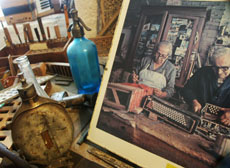|
(story cont'd from page
1)
Its beginnings can be traced to the turn of the 20th century,
when Scandalli, the son of a shepherd/farmer, began making
the daily 30-mile round trip by foot from Camerano to the
town of Castelfidardo. He wanted to work in the factories
of accordion innovator Paolo Soprani, the man credited with
establishing the first accordion factory in Italy.
While working in Soprani’s factory, Scandalli became
a sponge of information and innovation and eventually began
to produce accordions from his home. With the help of his
brother Enrico, Scandalli opened a small factory they called
“Scandalli Brothers” and continued to try to
improve upon what Soprani had accomplished in the previous
60 years.
Their innovations led to one of the biggest industrial
and economic booms in Camerano. Employment in Scandalli’s
factory, up a hill off the main piazza, grew from 400 to
700 workers and created many new jobs for the people of
Camerano and surrounding towns.
Other industrial firms began to explode throughout the region
in an attempt to imitate Scandalli’s success. They
included wood, plastic and metal mold manufacturers. “Scandalli
created an enterprising mentality through the people in
Camerano,” says Sandro Strologo, an expert on the
accordion industry who has written about Scandalli.
In 1946, in an effort to meet the increasing demands for
accordions, Scandalli merged his company with Settimio Soprani’s
(the brother of Paolo), and a third manufacturer from Numana
to form the “Farfisa” Company, a combination
of the Italian phrase “Fabbriche Riunite di Fisarmoniche”
meaning “Reunited Accordion Factories.”
Farfisa became one of the largest musical instrument manufacturers
in the world, producing about 180 accordions a day and employing
more than 1,600 workers.
“All the surrounding towns would offer workers and
the accordion industry area around Camerano little by little
enlarged the province,” says Strologo. Farfisa’s
success and production methods encouraged still others to
start their own factories, some employing as many as 600
employees. Scandalli’s greatest musical accomplishment
was the development, in 1951, of the “Super 6”
accordion, a model still considered to be the best accordion
in the world.
Farfisa also began producing other types of instruments
such as pianos, guitars, electric organs and even electric
accordions. The factory’s success drew significant
interest from foreign investors, including the American-based
company, Lear Siegler, which in 1968 became the major controlling
financial interest. |



